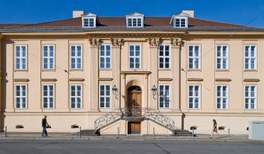Press Release
of the German Physical Society
The Magnus-Haus Berlin is EPS Historic Site
The Capital Representation of the German Physical Society (DPG) was awarded the honorary title "EPS Historic Site" by the European Physical Society (EPS).
Bad Honnef, 19. October 2021 – The Magnus-Haus Berlin at Kupfergraben 7, directly opposite the famous Pergamon Museum in Berlin-Center, is closely linked to physics through the work of important scholars. Reason enough for the European Physical Society (EPS) to designate the building as EPS Historic Site. In a ceremonial act on Friday, October 15, 2021, the presidents of the European Physical Society, Luc Bergé, and the German Physical Society (DPG), Lutz Schröter, therefore unveiled a commemorative plaque in the presence of other guests.
The DPG's capital city representative office and headquarters of the regional association Physikalische Gesellschaft zu Berlin (BGzB) thus joins buildings in Germany such as the Physikalisch-Technische Bundesanstalt (PTB) in Berlin, the Munich Ludwig Maximilians University, the former Institute of Physics in Würzburg, the former laboratories of Heidelberg scientists Gustav Robert Kirchhoff and Robert Wilhelm Bunsen, the former Institute of Physics at the University of Frankfurt, the RWTH Aachen and the city of Jena.
The Magnus-Haus Berlin was named after Gustav Magnus. The professor of technology bought the house in 1840 and founded Germany's first physics institute there two years later, which he directed until his death in 1870. In his laboratory, students were allowed to use his collection of physical apparatus, which he had built up from private funds, for their own experiments. Participants in the Physical Colloquium initiated by Magnus in 1843 founded the Physikalische Gesellschaft zu Berlin in 1845, which became the Deutsche Physikalische Gesellschaft in 1899.
Today, the Magnus-Haus Berlin serves as a scientific meeting place primarily to intensify the exchange of ideas for solving problems that physics can help with and that are of general importance to our society. In addition, offices, the lecture hall, conference rooms and the remise with the garden are rented out for scientific or cultural events. Former President of Germany, Richard von Weizsäcker, maintained an office in the west wing of the building until his death in 2015. In addition, the Magnus-Haus Berlin is the headquarters of the Atlantik-Brücke.
History of the Magnus-Haus Berlin
The building is a burgher's palace built under Frederick II in 1760. It is closely associated with physics through the work of important scholars.
In the 18th century, Joseph Louis Lagrange, one of the founders of analytical mechanics, lived and worked there. In 1840, Heinrich Gustav Magnus, who gave the house its name, purchased it. He set up his private physics laboratory there, which was also available for university teaching and is considered the oldest physics institute in Germany. Participants in the Physical Colloquium set up by Magnus founded the "Physikalische Gesellschaft zu Berlin" on January 14, 1845, from which the Deutsche Physikalische Gesellschaft emerged on January 6, 1899.
Among the important scientists whose work is associated with Magnus are Rudolf Clausius, Emil du Bois-Reymond, Josiah Willard Gibbs, Hermann von Helmholtz, Gustav Robert Kirchhoff, August Kundt, Georg Hermann Quincke, Werner von Siemens, John Tyndall, Emil Warburg, and Gustav Heinrich Wiedemann.
Magnus died in 1870, but his wife lived in the house until 1910. From 1911 to 1921, the house was then occupied by the director Max Reinhardt and his family. When his wife, the actress Else Heims, who had already divorced him by this time, had to emigrate in the 1930s and thus left the Magnus-Haus, it was used by the Friedrich Wilhelm University. In the immediate post-war period, the house was first briefly a Soviet remand prison. Subsequently, it served the Society for German-Soviet Friendship.
In 1958, on the occasion of Max Planck's 100th birthday, Mayor Friedrich Ebert gave the residence to the GDR Physical Society for permanent use. After German reunification, the increasingly dilapidated building was completely renovated by the German Physical Society. This was made possible in part by donations from Siemens AG and the Stiftung Deutsche Klassenlotterie Berlin. Since then, the Magnus-Haus Berlin has been used as a scientific meeting center and rented out for scientific or cultural events.
The German Physical Society (Deutsche Physikalische Gesellschaft e. V.; DPG), which was founded way back in 1845, is the oldest national and, with about 55,000 members, also the largest physical society in the world. As a non-profit-making organisation it pursues no economic interests. The DPG promotes the transfer of knowledge within the scientific community through conferences, events and publications, and aims to open a window to physics for the curious. Its special focuses are on encouraging junior scientists and promoting equal opportunities. The DPG’s head office is at Bad Honnef am Rhein. Its representative office in the capital is the Magnus-Haus Berlin. Website: www.dpg-physik.de
